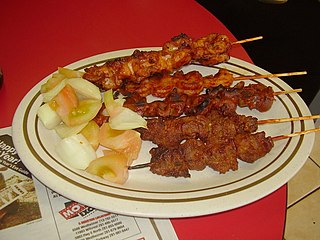 W
WCameroonian cuisine is one of the most varied in Africa due to Cameroon's location on the crossroads between the north, west, and center of the continent; the diversity in ethnicity with mixture ranging from Bantus, Semi-bantus and Shuwa Arabs, as well as the influence of German, French and English colonialization.
 W
WAchu soup is a traditional food in Cameroon, a yellow soup. It is made with cocoyam. Spices, water, palm oil, and "canwa or Nikki" (limestone), and fish are other ingredients.
 W
WEru is a soup from Cameroon. It is a specialty of the Bayangi people, of the Manyu region in southwestern Cameroon. It is vegetable soup made up of finely shredded leaves of the eru or okok. The eru is stewed with waterleaf or spinach, palm oil, and either smoked fish, cow skin (kanda) or beef.
 W
WFufu is a dough-like food made from fresh or fermented cassava, found in West African as well as Caribbean cuisines. In addition to Ghana, it is also found in Sierra Leone, Guinea, Liberia, Cote D'Ivoire, Benin, Togo, Nigeria, Cameroon, the Democratic Republic of Congo, the Central African Republic, the Republic of Congo, Angola and Gabon. It is often made in the traditional Ghanaian, Cote D'ivoire, Liberia and Cuban method of separately mixing and pounding equal portions of boiled cassava with green plantain or cocoyam, or by mixing cassava/plantains or cocoyam flour with water and stirring it on a stove. The viscosity is then adjusted based on personal preference and eaten with broth-like soups. Some countries, particularly Nigeria, have a version of fufu made from fermented Cassava dough that is eaten with thick textured stews. Other flours, such as semolina, maize flour, or mashed plantains may take the place of cassava flour. Fufu is eaten with the fingers, and a small ball of it can be dipped into an accompanying soup or sauce
 W
WIn West Africa, garri refers to the creamy granular flour obtained by processing the starchy tuberous roots of freshly harvested cassava.
 W
WKoose is a spicy black-eyed pea fritter that is commonly eaten in West Africa as a snack.
 W
WKwacoco, sometimes spelled kwa-coco, is a Cameroonian cuisine dish consisting in pureed cocoyam wrapped and steamed in banana leaves. It is consumed by different ethnic groups from Cameroon, specially the Kwe people, for whom the traditional meal usually consists in kwacoco served with banga, which is a soup made from a base of palm nut pulp, and smoked fish. It is sometimes referred to as kwacoco bible when the cocoyam is mixed with other ingredients such as spinach, smoked fish, red oil and spices, and it can also be served along with many other stews and soups.
 W
WMoin-Moin or Moimoi is a Nigerian steamed bean pudding made from a mixture of washed and peeled black-eyed beans, onions and fresh ground red peppers. It is a protein-rich food that is a staple in Nigeria.
 W
WNdolé is a Cameroonian dish consisting of stewed nuts, ndoleh and fish or beef.
 W
WSuya or tsire is a spicy meat skewer which is a popular food item in West Africa. It is also eaten in Sudan, referred to as "Agashe". Suya is generally made with skewered beef, ram, or chicken. Innards such as kidney, liver and tripe are also used. The thinly sliced meat is marinated in various spices which include peanut cake, salt, vegetable oil and other flavorings, and then barbecued. Suya is served with extra helpings of dried pepper mixed with spices and sliced onions. Halal meat preparation methods are normally used, especially in the northern parts of Nigeria, where the suspicion of nonconformity to Muslim dietary prohibitions in Suya preparation has been known to cause riots. A dried version of Suya is called Kilishi. It can be eaten with Garri or Ogi.